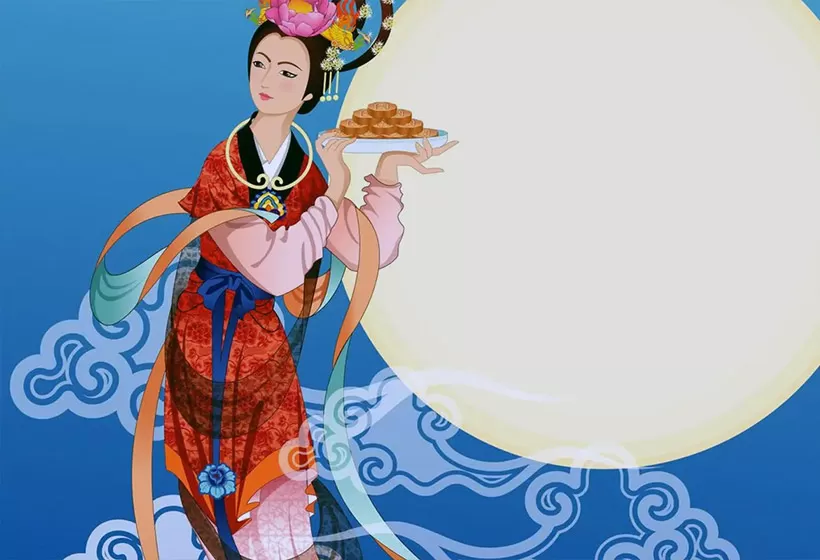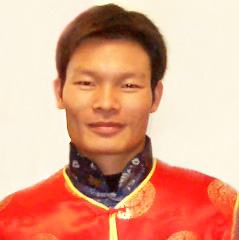Chinese Mid-Autumn Festival
- Chinese: 中秋节/ zhōng qiū jié
- When: end of September beginning of October
- Activities: worshiping the moon, admiring the moon, etc.
- Holiday: Mid-Autumn Festival is usually a 3-day holiday, if you add the weekend, it will be about 5 days, and if you add the National Day, it will be 7-10 days.
- Travel tips: Best to avoid Mid-Autumn Festival, if it is added to the number of days of the National Day holiday, it is a crowded time period.
The Moon Festival, also called the Mid-Autumn Festival or Mid-Autumn Day, is second in importance only to the Spring Festival. It falls on the 15th day of the 8th lunar month when the moon is believed to be the fullest and roundest. Members of the family gather together for a reunion dinner and to appreciate the moon while eating moon cakes of various flavors. It is also a festival for farmers to celebrate their harvest. With more than 3,000 years of history, there are different takes on the origin of this festival. Even the most popular one, the story of Hou Yi and Chang E, has different versions.
The Origin of the Mid-Autumn Festival
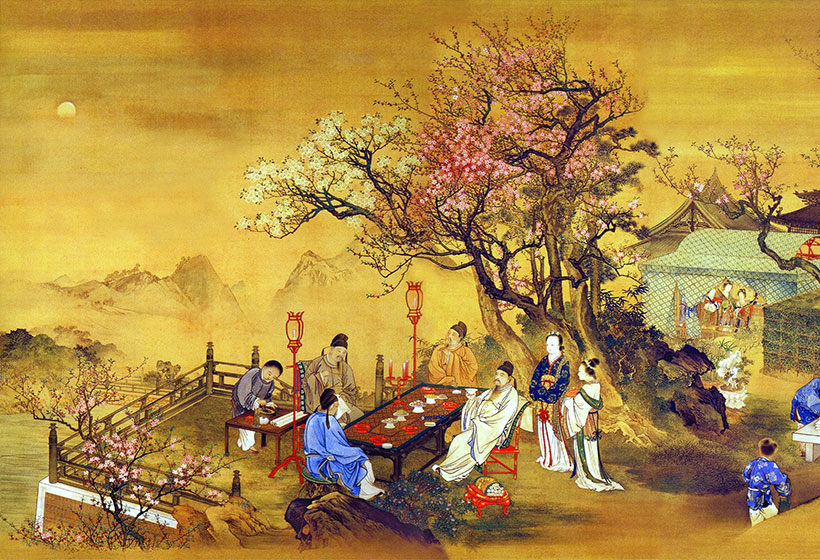 Watching the Moon
Watching the MoonThe origin of the Mid-Autumn Festival is inseparable from the moon, and the Mid-Autumn Festival is a relic of the custom of worshiping the moon in ancient times. During the autumnal equinox, it is the ancient "Moon Festival". Worshiping the moon is a very ancient custom in our country. In fact, it is a kind of worship activity for the "moon god" by the ancients in some parts of our country in ancient times. The Mid-Autumn Festival comes from the traditional "autumn equinox festival". In traditional culture, the moon is the same as the sun, and these two alternate celestial bodies became the objects of worship by the ancestors. The Mid-Autumn Festival originated from the worship of the moon by the ancients, and it is a relic and derivative of the custom of the Chinese nation to worship the moon. The Mid-Autumn Festival is a synthesis of autumn seasonal customs, and most of the festival elements contained in it have ancient origins.
History and development
The Mid-Autumn Festival originated from the worship of celestial phenomena and evolved from offering sacrifices to the moon on an autumn evening in ancient times. Sacrificing the moon is a very ancient custom in China. It is a kind of worship activity for the "moon god" by the ancients in some places in ancient China. During the autumnal equinox of the twenty-four solar terms, it is the ancient "Moon Festival". The Mid-Autumn Festival comes from the traditional "autumn equinox festival". In ancient farming societies, the ancients believed that the movement of the moon had a lot to do with agricultural production and seasonal changes, so offering sacrifices to the moon became an important sacrificial activity. As one of the important customs of folk festivals, offering sacrifices to the moon has gradually evolved into activities such as appreciating the moon and singing the praises of the moon.
Popularized in the Han Dynasty
The Mid-Autumn Festival was popularized in the Han Dynasty. The Han Dynasty was a period of economic and cultural exchanges and integration between the north and the south of China. The extant written records of the term "Mid-Autumn Festival" were first seen in the Han Dynasty documents, and there were activities of worshiping the moon in the pre-Qin Dynasty. According to records, in the Han Dynasty, there was an activity of respecting and providing for the elderly on the day of the Mid-Autumn Festival or the Beginning of Autumn and giving male pancakes. In the Jin Dynasty, there were also written records of the act of appreciating the moon during the Mid-Autumn Festival, but it was not very common. Before the Jin Dynasty, the Mid-Autumn Festival was not popular in northern China.
The official recognition of the Mid-Autumn Festival was in the Northern Song Dynasty
During the Northern Song Dynasty, the fifteenth day of the eighth lunar month was officially designated as the "Mid-Autumn Festival". The seasonal food of "small cakes are like chewing the moon, with crisp and glutinous rice in the middle" appears in literary works. Rich and noble people decorate their homes beautifully, while ordinary people seize the location of restaurants to enjoy the moon. The city is full of singing and dancing, full of people, and it is very lively all night long; even children stay up all night to watch the moon. It shows that people at that time loved the Mid-Autumn Festival.
It has become popular in northern China during the Tang Dynasty
The custom of the Mid-Autumn Festival became popular in northern China during the Tang Dynasty. In the Tang Dynasty, the Mid-Autumn Festival became an officially recognized national festival. "Tang Shu Taizong Ji" records "August 15 Mid-Autumn Festival". The custom of admiring the moon in the Mid-Autumn Festival was very popular in Chang'an area in the Tang Dynasty, and many famous poems of poets have verses chanting the moon. Combining the Mid-Autumn Festival with myths and stories such as Chang'e flying to the moon, Wu Gang cutting laurel, the jade rabbit pounding medicine, Yang Guifei turning into a moon god, Tang Minghuang visiting the moon palace, etc., makes it full of romance, and the wind of playing with the moon is just flourishing. The Tang Dynasty was an important period when traditional festival customs were combined and finalized, and the main part of them has been passed down to this day.
Grander in the Ming and Qing Dynasties
During the Ming and Qing Dynasties, the secular interest in festivals became stronger and stronger. During the moon appreciation activities in the Ming and Qing dynasties, "the fruit cakes for offering sacrifices must be round", and every family must set up a "moonlight stand" and "worship to the moon" in the direction of the moon. "In the mid-autumn night, people set up symbols of the Moon Palace, display melons and fruits in the court, and paint the moon palace toads on the cakes; men and women worship and burn incense, and burn them at dawn." The melons and fruits are arranged, and the petals are carved like lotus flowers. Women who stay at their mother’s house will return to their husband’s house on Mid-Autumn Festival, so it is also called the Reunion Festival.”
How do people spend the Mid-Autumn Festival now?
Up to now, eating moon cakes has become a must-have custom for the Mid-Autumn Festival in all parts of the north and south of China. Mooncakes symbolize reunion, and people regard them as festive foods, offering them to relatives and friends as offerings to the moon. In addition to moon cakes, various seasonal fresh and dried fruits are also delicacies in Mid-Autumn Festival. During the Mid-Autumn Festival, there are few clouds and fog, and the moonlight is bright and bright. There are a series of festival activities such as admiring the moon, offering sacrifices to the moon, eating moon cakes, eating sweet potatoes, carrying lanterns, dancing grass dragons, tree Mid-Autumn Festival, and building pagodas.
- 1. The transportation is convenient, the price of high-speed rail and bullet trains is not high, and the price of air tickets is also cheap. The common people are richer than before, and more people go home to reunite with their families during the Mid-Autumn Festival.
- 2. With the convenience brought by private cars, many people drive home to reunite with their families or take their families on a trip together to celebrate the Mid-Autumn Festival and enjoy the moon outside.
- 3. High-speed rail and trains bring convenience to travel. Many families take high-speed trains or trains for short trips during the Mid-Autumn Festival.
Date and Holidays of the Mid-Autumn Festival
The Mid-Autumn Festival is usually at the end of September or early October, and the holiday is 3 days; if it coincides with National Day, the holiday is from 7 to 10 days.
| Year | Date(Holiday) | Year | Date(Holiday) |
|---|---|---|---|
| 2023 | Sep. 29(29-Oct. 1) | 2029 | Sep. 22(22-24) |
| 2024 | Sep. 17(17-19) | 2030 | Sep. 12(12-14) |
| 2025 | Oct. 6(4-6) | 2031 | Oct. 1(1-3) |
| 2026 | Sep. 25(25-27) | 2032 | Sep. 19(18-20) |
| 2027 | Sep. 15(15-17) | 2033 | Sep. 8(8-10) |
| 2028 | Oct. 3(3-5) | 2034 | Sep. 27(27-29) |
Top 10 Interesting traditional activities during the Mid-Autumn Festival
The following activities are what most people will do during the Mid-Autumn Festival, and they are also very popular.
No. 1: Worship or Sacrificing the moon
- Chinese: 祭月(拜月)
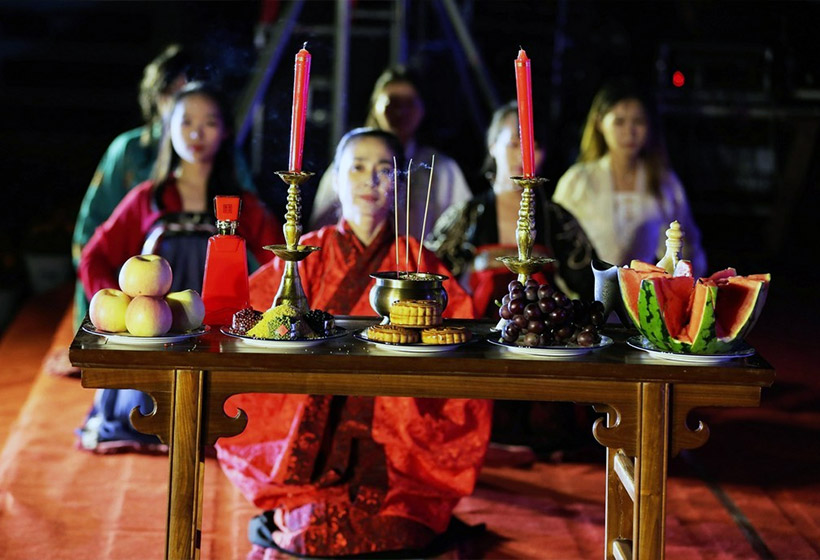 Worship the Moon
Worship the MoonSacrificing the moon is a very ancient custom in China. It is actually a kind of worship activity for the "moon god" by the ancients. In ancient times, there was a custom of "worship the moon in an Autumn evening". Xiyu(夕月), that is, to worship the moon god. Since ancient times, in some areas of Guangdong, people have had the custom of worshiping the moon god (worshiping the moon mother, worshiping the moonlight) on the night of the Mid-Autumn Festival. Worship the moon, set up a big incense table, and put moon cakes, watermelons, apples, red dates, plums, grapes and other sacrifices. Under the moon, put the tablet of the "Moon God" in the direction of the moon, and burn the red candles high. The whole family worships the moon one by one and prays for blessings. Offering sacrifices to the moon and admiring the moon, entrusting the moon to mourn, expressed people's best wishes. As one of the important ceremonies of the Mid-Autumn Festival, moon worship has continued from ancient times to the present, and has gradually evolved into folk activities of appreciating and singing the moon. At the same time, it has also become the main form of modern people's desire for a reunion and good wishes for life.
Materials for worshiping the moon
- 1. A sacrificial table or an ordinary small table is enough.
- 2. Several straw mats are used for worship. A cushion can be added to the ordinary straw mat.
- 3. A censer with some incense. Ordinary small incense burner will do.
- 4. A number of sacrificial containers such as plates and bowls.
- 5. Two red candles. Lighting, setting off the atmosphere, and can also be used for lighting incense.
- 6. One bottle of ordinary wine and three wines. Regular wine glasses will work too.
- 7. Offerings: moon cakes, glutinous rice cakes, wine, melons and fruits, edamame, cockscomb, etc.
No. 2: Admiring the moon
- Chinese: 赏月
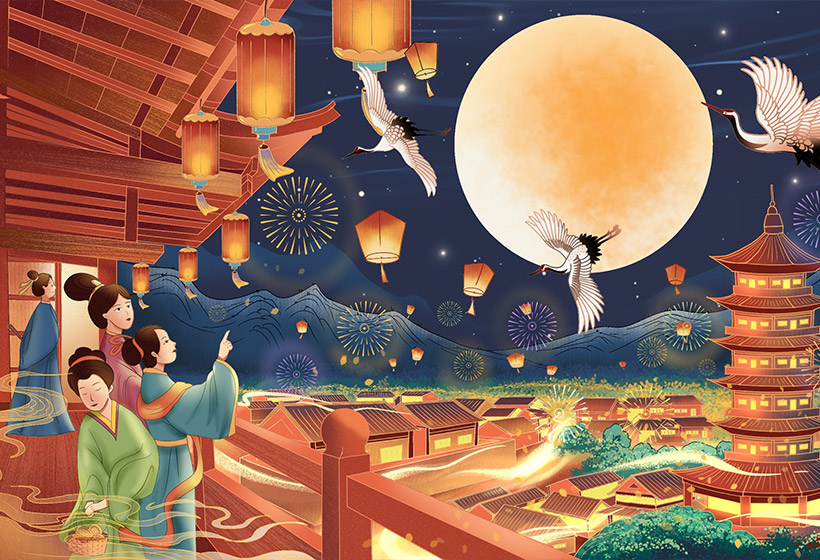 Admiring the moon
Admiring the moonThe custom of admiring the moon comes from offering sacrifices to the moon, and serious sacrifices have turned into relaxed entertainment. It is said that the moon is the closest to the earth at this night, and the moon is the largest, roundest and brightest, so there has been a custom of feasting and admiring the moon since ancient times. In ancient times, the customs of the north and the south were different, and the customs of different places were different. The written records of the activities of appreciating the moon in the Mid-Autumn Festival appeared in the Wei and Jin Dynasties, but they did not become a custom. In the Tang Dynasty, it was quite popular to enjoy and play with the moon during the Mid-Autumn Festival, and many famous poems of poets contained verses chanting the moon.
Appreciating the moon is an important custom of the Mid-Autumn Festival. It also refers to watching the full moon during the Mid-Autumn Festival on August 15th. Existing written records show that folk Mid-Autumn Festival moon appreciation activities began in the Wei and Jin Dynasties and flourished in the Tang Dynasty. There are poems chanting the moon in many famous poems of poets, and the court and folk activities of appreciating the moon in the Song and Ming dynasties were more extensive. On Mid-Autumn Festival, the moon is usually full.
How the ancients admire the moon
In ancient times, people took moon viewing very seriously, but it was not dull.
- Rich people will enjoy the moon on the pavilions with colorful decorations, and even build a moon viewing tower specially, prepare delicious food and wine, invite musicians, and enjoy the moon while feasting to the sound of melodious music;
- Ordinary people are much simpler, but not casual - they will set up tables in their yards, put incense candles, moon cakes, melons and fruits, and wine, etc., and the family will sit around drinking wine and tea, talking and watching the moon .
- There is also a way to enjoy the moon called "walking the moon". In fact, it is to go out with family or friends, or go boating on the lake, or take a walk in the countryside, and you can also hold various entertainment activities. The tourists are illuminated, and they seem to be eavesdropping on the jokes of the tourists. Compared with watching the moon at home, "walking the moon" is more free and lively.
No. 3: Eating moon cake
- Chinese: 吃月饼
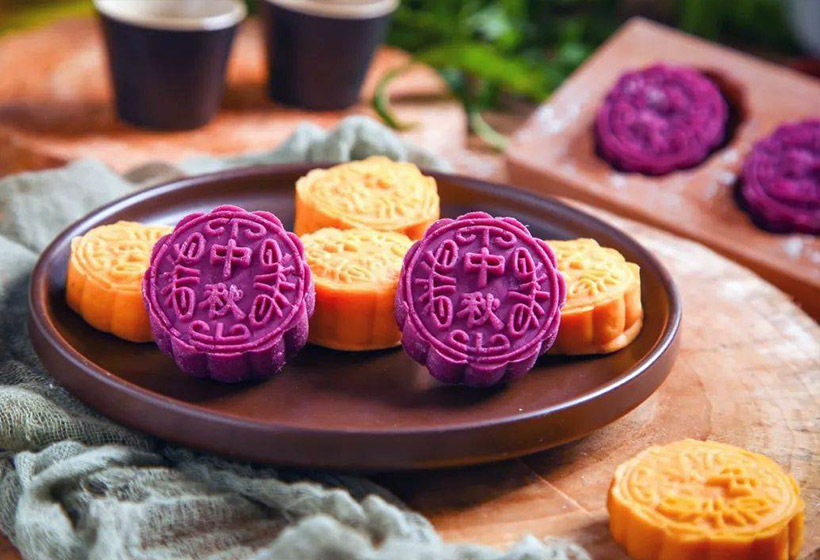 Eating moon cake
Eating moon cakeMoon cakes, also known as moon cakes, harvest cakes, palace cakes, reunion cakes, etc., were tributes to the Moon God during the Mid-Autumn Festival in ancient times. Moon cakes were originally used as offerings to the moon god. Later, people gradually regarded the Mid-Autumn Festival moon appreciation and tasting moon cakes as a symbol of family reunion. Mooncakes symbolize reunion, and people regard them as festive foods, offering them to relatives and friends as offerings to the moon. Up to now, eating mooncakes has become a must-have custom for the Mid-Autumn Festival in the north and south of China. On the Mid-Autumn Festival, people eat mooncakes to express "reunion".
No. 4: Guess lantern riddles
- Chinese: 猜灯谜
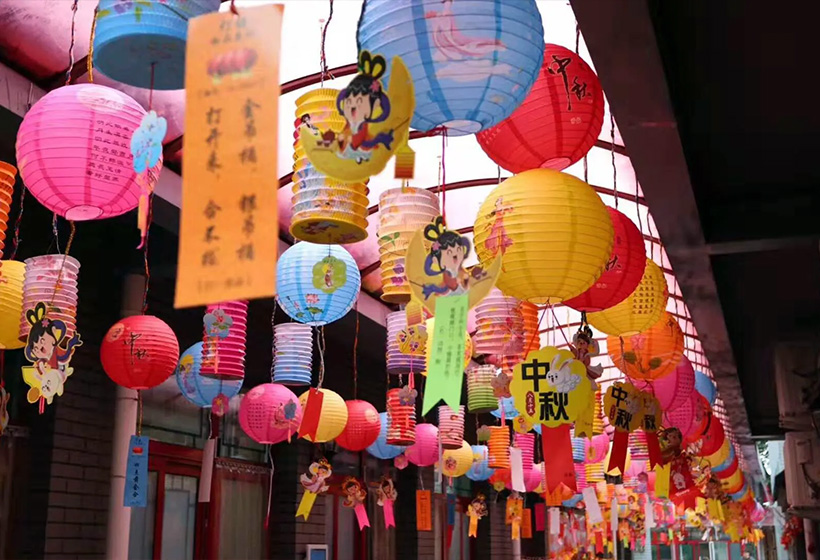 Guess lantern riddles
Guess lantern riddlesOn the full moon the night of the Mid-Autumn Festival, many lanterns are hung in public places, and people gather together to guess the riddles written on the lanterns. Because it is an activity that most young men and women alike, and there are also love stories in these activities, so guessing lantern riddles on Mid-Autumn Festival has also been derived as a form of love between men and women.
No. 5: Fire dragon dance
- Chinese: 舞火龙
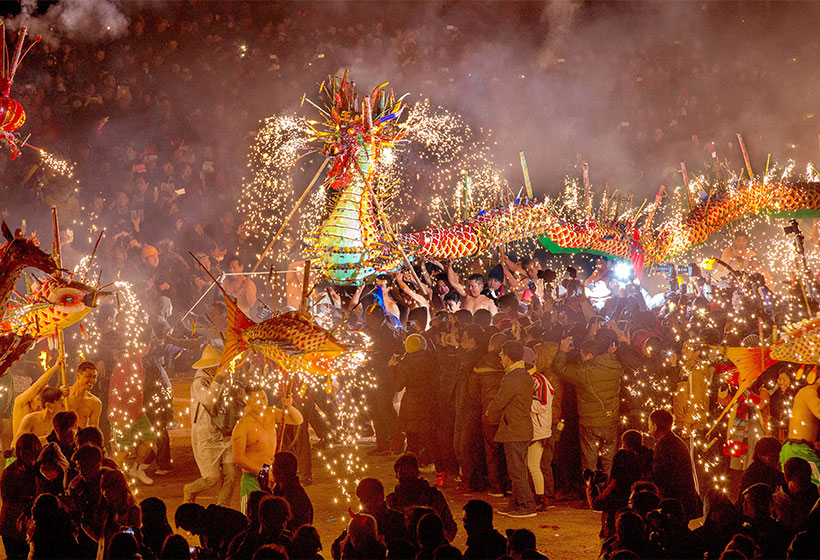 Fire dragon dance
Fire dragon danceFire dragon dance is the most traditional custom of Mid-Autumn Festival in Hong Kong. From the fourteenth night of the eighth lunar month every year, a grand fire dragon dance is held in the Tai Hang area of Causeway Bay for three consecutive nights. The fire dragon is more than 70 meters long. It has a 32-section dragon body made of pearl grass and filled with longevity incense. On the night of the grand event, the streets and alleys of this district are full of undulating fire dragons dancing joyfully under the lights and dragon drum music, which is very lively.
Nicknames of the Festival
At first, the "Moon Festival" was held on the day of the "autumn equinox" of the twenty-four solar terms in the Ganzhi (Heavenly Stems and Earthly Branches) calendar. Later, it was adjusted to the fifteenth day of the eighth month in the summer calendar (lunar calendar). According to the Chinese calendar, the eighth month of the lunar calendar is in the middle of autumn, which is the second month of autumn.
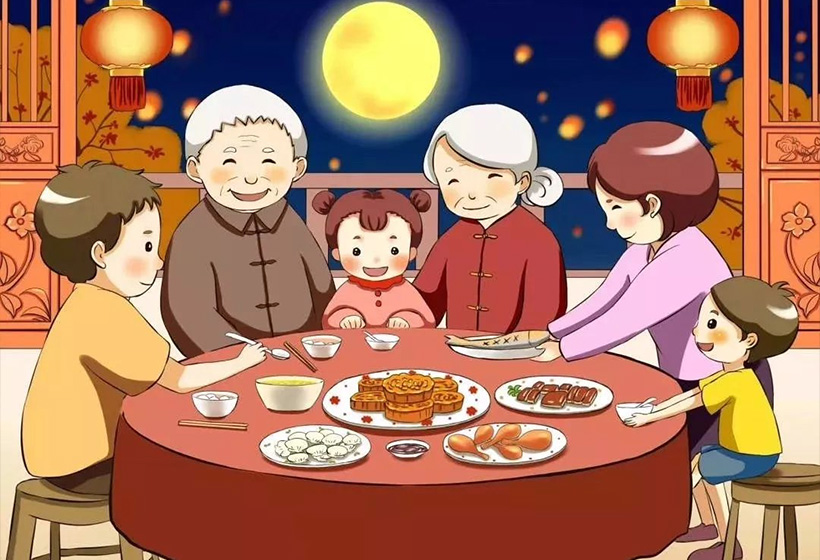 Reunion Festival
Reunion FestivalThere are many nicknames for the Mid-Autumn Festival: In ancient times, there was an activity of autumnal equinox and eve (worshiping the moon), so it was called "Yuexi/月夕" or "Moon Festival/祭月节". Because the festival is on August 15th, it is called "August Festival/八月节" and "August half/八月半". , a symbol of reunion, so it is also called the "Reunion Festival/团圆节". The Mid-Autumn Festival is a time when the moon is full, family reunions, and married daughters go home for a reunion, so it is also called the "Reunion Festival/团圆节" and "Daughter's Day/女儿节". In Guangfu area, the Mid-Autumn Festival is commonly known as the "Moonlight Festiva/月光诞". In mid-autumn, all kinds of melons and fruits are ripe and on the market, so it is called the "Fruit Festival/果子节". The Dong people call it the "Pumpkin Festival/南瓜节", and the Mulao people call it the "Housheng Festival/后生节".
The Legend of the Moon Festival
The Moon Festival legend about Hou Yi and Chang E is always told to children at this time. Once upon a time, there were ten suns in the sky, scorching many crops and people to death. The Emperor of Heaven summoned Hou Yi to shoot down nine of the suns. Hou Yi succeeded, the weather soon recovered and life was saved. Hou Yi was rewarded with the elixir of immortality. While Hou Yi was still on Earth, he met Chang E, and they fell in love and were married.
Hou Yi wanted to spend his life with Chang E forever, so he went to the Western Queen Mother to ask for the elixir of life. For the good deeds that Hou Yi had performed for the Earth, the Western Queen Mother agreed to give him the elixir, sufficient for two people, half each. Hou Yi returned home and told his wife. They decided to drink it together on the 15th day of the 8th lunar month when the moon was round and bright. But a wicked man named Feng Meng overheard them and wanted the elixir for himself.
On the 15th day, before Hou Yi returned home from hunting, Feng Meng went to Hou Yi's home and forced Chang E to give him the elixir. She knew that she could not defeat Feng Meng so, with no other choice, she drank the elixir all by herself. When Hou Yi came back, he found that his wife had been lifted to Heaven. Chang E decided to live on the Moon because it's closest to the Earth. Hou Yi looked up at the moon and put the foods Chang E used to love in the garden as a sacrifice. Thus, people started admiring the moon on this day. Later, Chang E and Hou Yi came to represent the yin and yang respectively (the moon and the sun).
Story of Moon-Cakes
Moon cakes are eaten during the Moon Festival. Without mooncakes, the festival is considered incomplete. This round pastry can contain various ingredients in a thin crust. Most of the flavors are sweet, with lotus seed paste or sweet bean paste in the center.
Once, according to a Chinese legend, moon cakes helped the start of a revolution. It happened during the Yuan dynasty (AD 1280-1368) founded by Mongolians from the north. It was said that a Han Chinese rebel leader, Liu Bo Wen, planned to arouse the Han Chinese to rise up against the ruling Mongolians and end the Yuan dynasty. He gained permission to give gifts to his friends on different bases. These gifts were round moon cakes. Liu asked his subordinates to hide pieces of paper in the cakes with the date of the Han Chinese rebellion (the 15th night of the 8th lunar month). Thus, Liu got word to his people who found the revolutionary message when they cut open the moon cakes. They then set out together to overthrow the Mongolians, thus ending the Yuan dynasty.
Nowadays, Chinese communities all over the world eat moon cakes during the Moon Festival, such as the Chinatowns in the USA, Canada, Europe, Australia and throughout the world. Some countries like Vietnam and Singapore also celebrate this traditional festival.
GREAT FAMILY CHINA TOUR
JULY 2024 We wanted to thank Grace at China Culture tour for organizing a great tour of China. We enjoyed our Beijing - Xian-Chengdu -Guilin -Yangshuo - Shanghai trip. Our local guides Bruce in Beijing, Susan in Xian, Jane in Chengdu, Mike in Guilin and Mary in Shanghai took care of us…read more details »
Teng Han L from SINGAPORE
Ready to Create a Unique Dream Travel?
